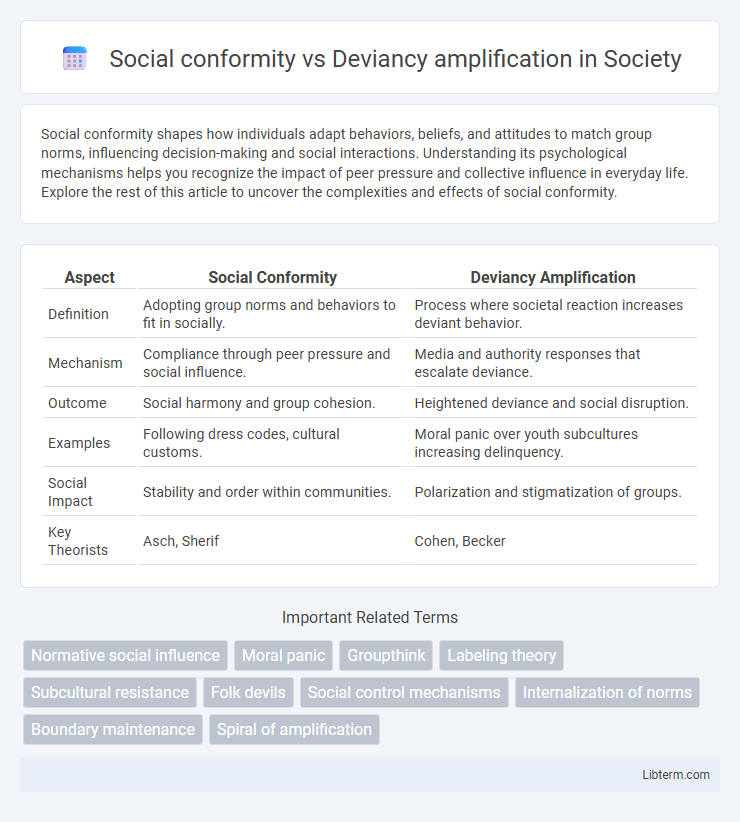Social conformity shapes how individuals adapt behaviors, beliefs, and attitudes to match group norms, influencing decision-making and social interactions. Understanding its psychological mechanisms helps you recognize the impact of peer pressure and collective influence in everyday life. Explore the rest of this article to uncover the complexities and effects of social conformity.
Table of Comparison
| Aspect | Social Conformity | Deviancy Amplification |
|---|---|---|
| Definition | Adopting group norms and behaviors to fit in socially. | Process where societal reaction increases deviant behavior. |
| Mechanism | Compliance through peer pressure and social influence. | Media and authority responses that escalate deviance. |
| Outcome | Social harmony and group cohesion. | Heightened deviance and social disruption. |
| Examples | Following dress codes, cultural customs. | Moral panic over youth subcultures increasing delinquency. |
| Social Impact | Stability and order within communities. | Polarization and stigmatization of groups. |
| Key Theorists | Asch, Sherif | Cohen, Becker |
Understanding Social Conformity: Definitions and Theories
Social conformity involves adhering to group norms and behaviors to gain acceptance or avoid rejection, supported by theories such as normative social influence and informational social influence. Normative social influence explains conformity driven by the desire for social approval, while informational social influence arises when individuals accept information from others as evidence of reality. Understanding these mechanisms reveals how social conformity shapes individual behavior within groups and contrasts with deviancy amplification, where attempts to control deviance lead to increased deviant behavior.
The Roots and Mechanisms of Deviancy Amplification
Deviancy amplification originates from societal reactions that exaggerate the perception of deviant behavior, often fueled by media sensationalism and public outcry. This process involves a feedback loop where increased attention leads to heightened deviance, reinforcing negative stereotypes and social control measures. Key mechanisms include moral panic, labeling theory, and social amplification, which collectively escalate the visibility and consequences of deviant acts beyond their initial scope.
Social Norms: How They Shape Individual Behavior
Social norms serve as powerful frameworks that guide individual behavior by establishing expectations for acceptable actions within a group or society. Conformity to these norms reinforces social cohesion and predictability, while deviations often trigger social sanctions or corrective measures. The process of deviancy amplification can occur when minor norm violations are exaggerated, leading to increased deviance and heightened social control efforts.
Media Influence on Deviant Labels and Public Perception
Media influence significantly shapes public perception by amplifying deviant labels through selective reporting and sensationalism, often reinforcing social conformity. The portrayal of certain behaviors or groups as deviant by mass media can lead to increased social stigmatization and marginalization, creating a feedback loop that intensifies deviant behavior, known as deviancy amplification. This process highlights the media's role in constructing social realities that influence both individual identity and collective societal norms.
Case Studies: Real-World Examples of Deviancy Amplification
Deviancy amplification is exemplified in the Mods and Rockers conflict of 1960s Britain, where media exaggeration of minor disturbances led to heightened public fear and increased police intervention. Another significant case is the 1980s UFO sightings in the United States, where sensational media coverage amplified public panic and spawned a wave of conspiracy theories. These case studies illustrate how media-driven deviancy amplification escalates societal reactions and can distort public perception of social conformity and deviant behavior.
Group Dynamics: Peer Pressure and the Drive to Conform
Group dynamics significantly influence social conformity through peer pressure, where individuals adjust behaviors to match group norms, ensuring acceptance and reducing social conflict. Deviancy amplification occurs when societal reactions to deviant behavior increase the visibility and frequency of that behavior, often intensifying peer influence and reinforcing group boundaries. The interplay between the desire for social acceptance and external labeling drives individuals to conform or deviate, shaping collective behavior patterns within communities.
The Role of Authority in Establishing Social Standards
Authority plays a crucial role in establishing social standards by defining acceptable behavior and reinforcing conformity through explicit rules and sanctions. When authorities label certain behaviors as deviant, these actions may be amplified in public perception, intensifying social exclusion and stigmatization. The interaction between authority-driven norms and societal reaction often shapes the dynamics between social conformity and deviancy amplification.
Consequences of Excessive Conformity in Society
Excessive social conformity can lead to the suppression of individual creativity and innovation, resulting in a stagnant cultural and intellectual environment. This pressure to conform increases the risk of groupthink, where critical thinking is diminished and flawed decisions gain consensus, potentially harming societal progress. In contrast, deviancy amplification highlights how society's reaction to deviant behavior can unintentionally increase the prevalence of such behavior, but unchecked conformity risks enforcing harmful norms without challenge.
Counteracting Deviancy Amplification: Strategies and Solutions
Counteracting deviancy amplification requires implementing community-based interventions that promote positive social norms and reduce stigmatization of deviant behavior. Effective strategies include enhancing social support networks, fostering open communication between law enforcement and communities, and applying restorative justice practices to prevent escalations caused by label-induced deviance. Evidence-based policies emphasizing education, youth engagement, and media responsibility are essential to mitigate the cyclical effects of deviancy amplification and promote social cohesion.
Balancing Social Order and Healthy Deviance for Progress
Balancing social order with healthy deviance is crucial for societal progress, as conformity maintains stability while controlled deviance fosters innovation and change. Excessive social conformity risks stagnation by suppressing alternative viewpoints, whereas deviancy amplification can lead to moral panic and social disorder. Sustainable progress relies on managing this dynamic tension to encourage constructive challenges to norms without undermining collective cohesion.
Social conformity Infographic

 libterm.com
libterm.com